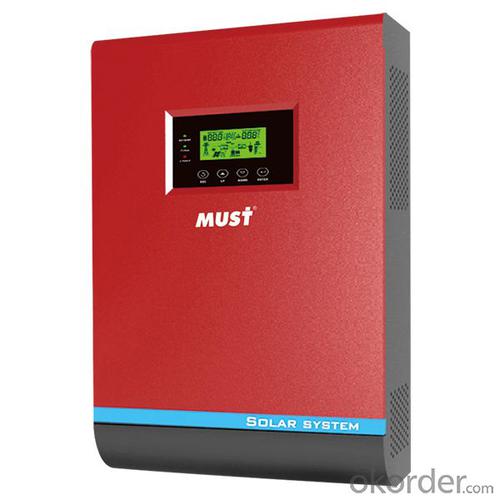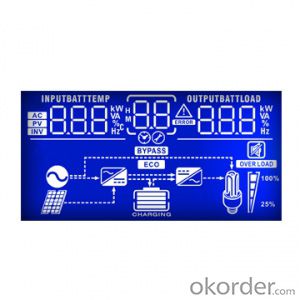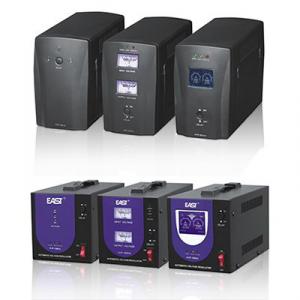1440W Solar Inverter Charge Controller Hybrid Inverter Excellent Quality 2000VA with Competitive Price
- Loading Port:
- China main port
- Payment Terms:
- TT OR LC
- Min Order Qty:
- 10 pc
- Supply Capability:
- 1000 pc/month
OKorder Service Pledge
OKorder Financial Service
You Might Also Like
Features:
. Pure sine wave inverter
. Selectable input voltage range for home appliances and personal computers
. Selectable charging current based on applications
. Configurable AC/Solar input priority via LCD setting
. Compatible to mains voltage or generator power
. Parallel operation with up to 4 units only available for PV200 4KVA/5KVA
. Auto restart while AC is recovering
. Overload and short circuit protection
. Smart battery charger design for optimized battery performance
. Cold start function
| Model | PV1800-1KVA | PV1800-2KVA | PV1800-3KVA | PV1800-4KVA | PV1800-5KVA |
| RATED POWER | 1000VA / 800W | 2000VA/ 1600W | 3000VA / 2400W | 4000VA / 3200W | 5000VA / 4000W |
| INPUT | |||||
| Voltage | 230 VAC | ||||
| Selectable Voltage Range | 170-280 VAC (For Personal Computers) ; 90-280 VAC (For Home Appliances) | ||||
| Frequency Range | 50 Hz/60 Hz (Auto sensing) | ||||
| OUTPUT | |||||
| AC Voltage Regulation (Batt. Mode) | 230 VAC ± 5% | ||||
| Surge Power | 2000VA | 4000VA | 6000VA | 8000VA | 10000VA |
| Efficiency (Peak) | 90% | 93% | |||
| Transfer Time | 10 ms (For Personal Computers) ; 20 ms (For Home Appliances) | ||||
| Waveform | Pure sine wave | ||||
| BATTERY | |||||
| Battery Voltage | 12 VDC | 24 VDC | 48 VDC | ||
| Floating Charge Voltage | 13.5 VDC | 27 VDC | 54 VDC | ||
| Overcharge Protection | 15 VDC | 30 VDC | 60 VDC | ||
| Maximum Charge Current | 10 A or 20 A | 20 A or 30 A | 20 A or 30 A | ||
| SOLAR CHARGER (OPTION) | |||||
| Charging Current | 50 A | ||||
| Maximum PV Array Open Circuit Voltage | 30 VDC | 60 VDC | 90 VDC | ||
| Standby power Consumption | 1 W | 2 W | 2 W | ||
| PHYSICAL | |||||
| Dimension, D x W x H (mm) | 95 x 240 x 316 | 100 x 272 x 355 | 120 x 295 x 468 | ||
| Net Weight (kgs) | 5.0 | 6.4 | 6.9 | 9.8 | 9.8 |
| OPERATING ENVIRONMENT | |||||
| Humidity | 5% to 95% Relative Humidity(Non-condensing) | ||||
| Operating Temperature | 0°C - 55°C | ||||
| Storage Temperature | -15°C - 60°C | ||||
Warranty
provides a 1~3 year limited warranty (“Warranty”) against defects in materials and workmanship for its Uninterruptible power supply, Power inverter/chargers, Solar charge controllers, Battery Products (“Product”).
The term of this Warranty begins on the Product(s) initial purchase date, or the date of receipt of the Product(s) by the end user, whichever is later. This must be indicated on the invoice, bill of sale, and/or warranty registration card submitted to MUST-Solar. This Warranty applies to the original MUST-Solar Product purchaser, and is transferable only if the Product remains installed in the original use location.
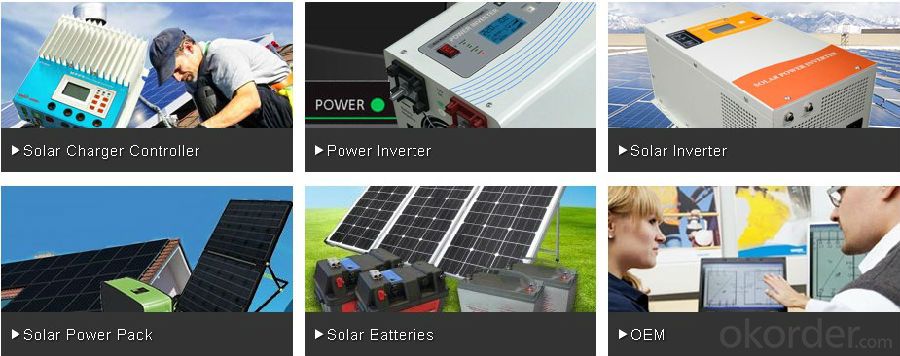

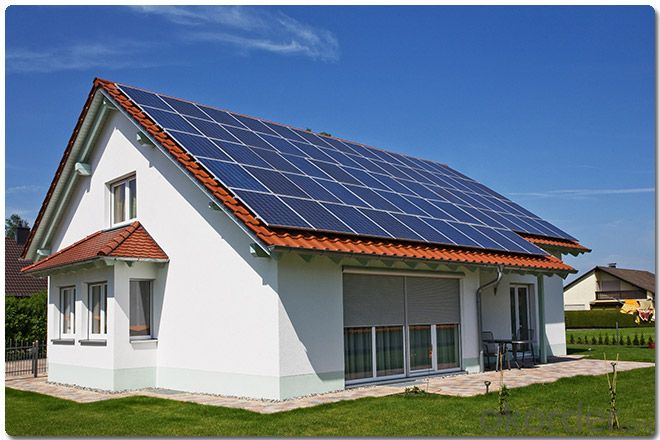
FAQ
1. How fast will my system respond to a power outage?
Our solar inverters typically transfer to battery power in less than 16 milliseconds (less than 1/50th of a second).
2. What kind of batteries do the systems include?
Our solar backup electric systems use special high-quality electric storage batteries.
3. How do I install my system?
A solar backup inverter is connected to a home electric system , we will supply detailed installation manual and videos for our customers .
- Q: How does a solar inverter communicate with other devices in a solar power system?
- A solar inverter communicates with other devices in a solar power system through various communication protocols such as Wi-Fi, Ethernet, or RS485. These protocols enable the inverter to exchange data and information with devices like solar panels, batteries, energy management systems, or monitoring devices. This communication allows for real-time monitoring, control, and optimization of the solar power system's performance.
- Q: How does a solar inverter handle voltage harmonics?
- A solar inverter handles voltage harmonics by incorporating filters and control algorithms that mitigate harmonics and ensure a smooth and stable output voltage.
- Q: What is the maximum DC voltage that a solar inverter can handle?
- The maximum DC voltage that a solar inverter can handle varies depending on the specific model and manufacturer. However, most modern solar inverters can typically handle DC voltages up to 1000 volts or higher. It is important to consult the manufacturer's specifications and guidelines to determine the exact maximum voltage rating for a particular solar inverter.
- Q: What is the maximum AC current output of a solar inverter?
- The maximum AC current output of a solar inverter depends on its size and rating. It can range from a few amps to several hundred amps, typically ranging between 5-100 amps for residential inverters and going up to higher currents for commercial or utility-scale inverters.
- Q: Can a solar inverter be used with a solar-powered desalination system?
- Yes, a solar inverter can be used with a solar-powered desalination system. A solar inverter is needed to convert the direct current (DC) produced by solar panels into alternating current (AC) that can be used to power the desalination system. This allows for the efficient utilization of solar energy in powering the desalination process.
- Q: Photovoltaic grid-connected inverter problem
- But Baidu Encyclopedia clearly pointed out: the zero line is the secondary side of the transformer leads the neutral point of the line, and the phase line constitutes a circuit for power supply equipment.
- Q: Can a solar inverter be used in systems with different module strings?
- Yes, a solar inverter can be used in systems with different module strings. Solar inverters are designed to convert the direct current (DC) generated by solar panels into alternating current (AC) for use in the electrical grid or for powering appliances. They are typically capable of handling a wide range of input voltage and current from different module strings, allowing for flexibility in system design and integration.
- Q: How does the input power rating affect the performance of a solar inverter?
- The input power rating of a solar inverter directly affects its performance. A higher input power rating allows the inverter to handle a greater amount of solar energy, resulting in a higher energy conversion efficiency and overall performance. On the other hand, a lower input power rating may limit the inverter's capacity to handle larger solar systems, potentially leading to lower efficiency and reduced performance. Therefore, selecting an inverter with an appropriate input power rating is crucial to ensure optimal performance in a solar energy system.
- Q: How does a solar inverter handle variations in solar panel tilt and orientation?
- A solar inverter handles variations in solar panel tilt and orientation by adjusting the power output to maximize the energy harvest. It continuously monitors the performance of the solar panels and adjusts the voltage and current levels to optimize the conversion of sunlight into usable electricity. This allows the inverter to accommodate changes in tilt and orientation, ensuring the system operates at its highest efficiency regardless of the panel position.
- Q: What is the maximum power output of a solar inverter?
- The maximum power output of a solar inverter depends on its capacity and specifications. It can range from a few hundred watts to several kilowatts for residential inverters, and even higher for commercial or utility-scale inverters.
Send your message to us
1440W Solar Inverter Charge Controller Hybrid Inverter Excellent Quality 2000VA with Competitive Price
- Loading Port:
- China main port
- Payment Terms:
- TT OR LC
- Min Order Qty:
- 10 pc
- Supply Capability:
- 1000 pc/month
OKorder Service Pledge
OKorder Financial Service
Similar products
Hot products
Hot Searches
Related keywords





